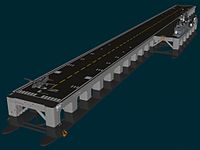
Photo from wikipedia
Abstract Inspired by the curtain-wall type breakwater, this paper introduced a reversed L type breakwater-WEC structure which is a rectangular floating breakwater with a vertical curtain wall restrained in piles.… Click to show full abstract
Abstract Inspired by the curtain-wall type breakwater, this paper introduced a reversed L type breakwater-WEC structure which is a rectangular floating breakwater with a vertical curtain wall restrained in piles. To present the performance of the new system, a numerical model based on N–S equations is introduced and validated. A numerical study is carried out to illustrate the factors on the hydrodynamic properties and structure loads of the breakwater-WEC, including the PTO damping force, the wave frequency, draft, and height of the curtain wall. It is found that its performance gets enhanced with a higher curtain wall with the expense of greater structure loads. The sensitivity analysis found that the hydrodynamic performance is sensitive to the draft and PTO damping force while the height of the curtain wall has the most influence on the restraining moment. The smaller draft gives larger capture ratio width (CWR) but slight larger transmission coefficient Ct, as well as smaller wave forces and larger wave moment. The CWR increases firstly and decreases as a function of PTO damping force while Ct shows a reverse trend. Therefore, with proper configuration, the breakwater-WEC system can achieve a satisfied level with the CWR>40% and Ct
Journal Title: Ocean Engineering
Year Published: 2021
Link to full text (if available)
Share on Social Media: Sign Up to like & get
recommendations!